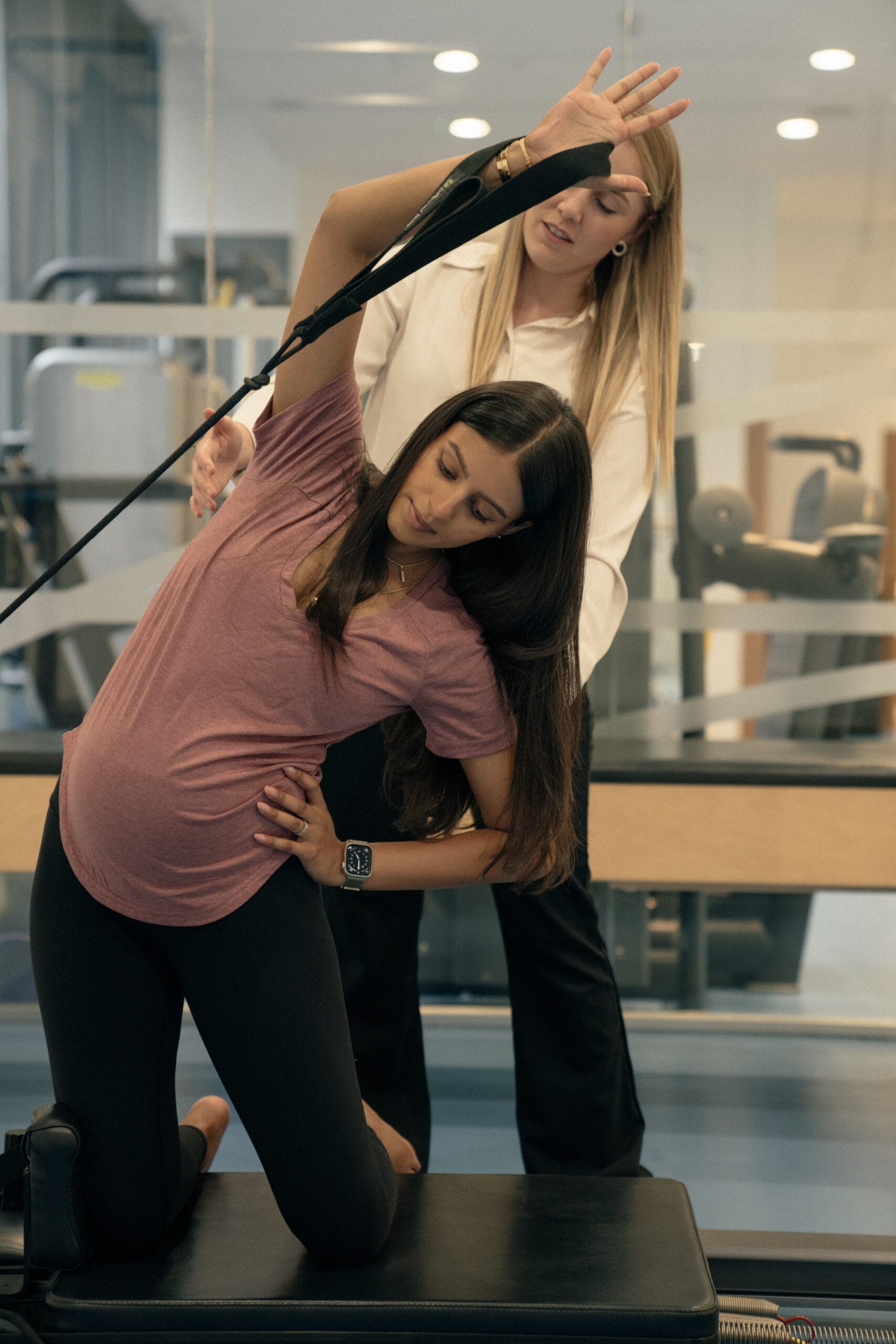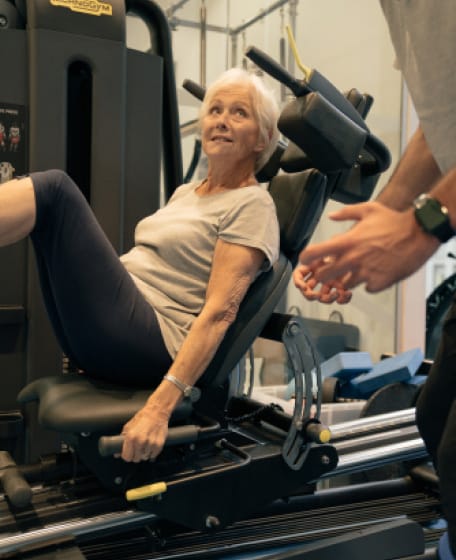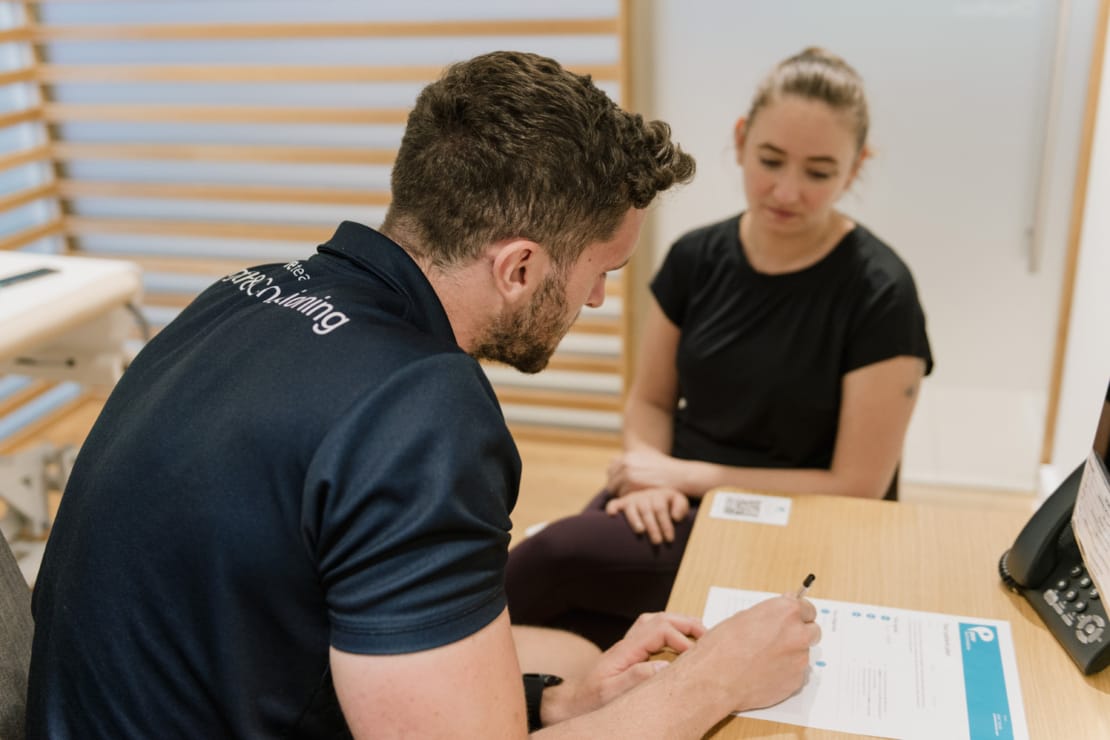Pilates During Pregnancy: Benefits and Focus Areas

Dr Sarah Rollins
Consultant in Sport, Exercise & Musculoskeletal Medicine
- 16 October, 2025
- Women's Health
- Exercise
- Yoga & Pilates
- 5 min read
Pilates During Pregnancy: Safe for Strength, Posture & Wellbeing

One of the most common questions I hear is: “Is it safe to do Pilates while I’m pregnant?”
The answer is: “Absolutely!”
You can typically continue Pilates throughout your pregnancy, right up until delivery, as long as it feels comfortable and your healthcare provider agrees. Even at 30 weeks, Pilates can be incredibly beneficial for posture, mobility, and preparing your body for labour.
Exercise and Pregnancy: How Much Is Recommended?
For those with non-complicated pregnancies, the general guideline is 150 minutes of moderate-intensity activity each week along with two sessions focused on muscle strengthening. Pilates is an ideal choice for this, and yoga can also be beneficial depending on the style. Be sure to include pelvic floor exercises as part of your routine, as these support your body before, during, and after birth.
If you’re already active, you can usually continue your routine with appropriate modifications. However, it’s best to avoid starting entirely new and strenuous forms of exercise during your first trimester unless recommended by your healthcare provider. That said, beginning gentle activities such as swimming or Pilates at an appropriate level is safe in any trimester
Dr Sarah Rollins, Consultant in Sport, Exercise and MSK Medicine at Pure Sports Medicine adds: “Always avoid activities that risk ‘bumping the bump,’ and be cautious with movements that challenge balance or stability.”
Starting Pilates During Pregnancy
“Interestingly, I’ve had many patients who began Pilates after discovering they were pregnant, which is perfectly fine, provided it’s done safely,” explains Harriet Ranger, Specialist Pelvic Health & MSK Physiotherapist at Pure Sports Medicine. “The best way to start is with a one-to-one session led by an instructor experienced in prenatal Pilates. This ensures the exercises are tailored to your stage of pregnancy and your individual needs.”
“Prenatal-specific classes are designed for pregnancy, led by qualified instructors, and provide a social, supportive environment. One-to-one sessions, on the other hand, are ideal if you have back or pelvic pain, or a high-risk pregnancy that requires closer supervision.”
“If your pregnancy is low risk and you’re comfortable in a group setting, start with a prenatal class. If you need more individual attention, switch to private sessions for additional support.”
Benefits of Pilates During Pregnancy
As your body changes, so should your Pilates practice. The benefits of Pilates during pregnancy go far beyond maintaining strength and flexibility. It’s also about helping you stay connected to your changing body, preparing for childbirth, and supporting postpartum recovery.
Physical Benefits
Pilates helps improve posture and alignment as your centre of gravity shifts, strengthening your core and back to reduce strain and discomfort. It also enhances pelvic floor awareness, helping to prevent incontinence and aid recovery after birth.
“Regular Pilates practice can relieve lower back pain, hip tightness, and pelvic instability while maintaining muscle tone and stamina. Staying active also reduces the risk of gestational diabetes, high blood pressure, swelling, and excessive weight gain,” adds Harriet.
Mental and Emotional Benefits
Beyond the physical, Pilates promotes relaxation and mindfulness through controlled breathing which can help support your nervous system, help you to manage contractions and promote calm during labour. Gentle, mindful movement can boost your mood, fight fatigue, and encourages a deeper connection with your baby.
Many women also find that consistent prenatal Pilates can also lead to a smoother postpartum recovery.
You can explore more supportive care options for pregnancy and beyond through our Women’s Health Physiotherapy services or our dedicated Mummy MOT rehab and recovery programme.
What Is Better for Pregnancy – Pilates or Yoga?
Both Pilates and yoga are excellent during pregnancy, but they serve slightly different purposes. Prenatal yoga focuses on flexibility, mindfulness, and relaxation, while Pilates places more emphasis on posture, strength, and control.
Combining the two can be ideal, with yoga to calm the mind and Pilates to stabilise the body. However, if your main goals are to improve posture, reduce back pain, and prepare for labour, Pilates tends to be more targeted and functional.
“However, it’s important to avoid hot yoga and any activities that raise your body temperature excessively, as high heat can be harmful to the developing baby, and can also increase the risk of dehydration, particularly in early pregnancy,” states Dr Sarah. “This can include saunas, hot tubs and steam rooms.”
“Additionally, due to hormonal changes that increase joint laxity, static stretching should be avoided. Opt instead for gentle, flowing movements and avoid holding deep stretches for prolonged periods.”
When Is the Best Time to Start Pilates During Pregnancy?
Beginning either mat or Reformer Pilates during your first trimester is perfectly safe. Although pregnancy brings many changes, women should feel confident and encouraged to stay active. Regular movement can help ease symptoms, such as morning sickness and boost overall energy levels.
In Reformer Pilates, the spring resistance provides ample support while gently challenging your muscles to build strength and stability. Just be sure your instructor is trained in prenatal Pilates so they can adapt exercises and positions to suit your needs.
Always consult your GP, Women’s Health Physiotherapist, or Sports, Exercise & Musculoskeletal Consultant before beginning or adjusting your programme.
What Are Some of The Best Pilates Exercises During Pregnancy?
Some of the most effective Pilates exercises during pregnancy include:
- Pelvic tilts to support your lower back and posture
- Cat-Cow stretches to relieve tension and improve spinal mobility
- Side-lying leg lifts to strengthen the hips and glutes
- Kneeling arm and leg reaches to promote stability and balance
- Gentle seated twists to release tension in the spine
These moves focus on breath, alignment, and strength while accommodating your growing bump.
For those with a regular exercise routine, squats are also beneficial for strengthening the legs, glutes, and pelvic floor in preparation for labour. Focus on maintaining good form and avoid deep squats if they cause discomfort.
Additionally, you can continue to complete core exercises; however, these should focus on stability, not flattening the stomach. Safe core exercises include gentle pelvic tilts, transverse abdominis activation, and breath-based engagement.
For added variety, combine Pilates with a pregnancy-safe Strength and Conditioning programme for balanced resistance training.
When to Modify Pilates Exercises?
First trimester (0-12 weeks): Focus on gentle breathing, posture, and awareness. Avoid overheating and intense core work. Fatigue and nausea may limit activity, so listen to your body.
Second trimester (13-27 weeks): Most people find the second trimester the best for consistent exercise. Your energy levels return, nausea subsides, and you can safely perform Pilates movements with appropriate adjustments
As your bump starts to grow, begin adapting positions that would normally involve lying flat on your back for long periods. Exercises on hands and knees, seated, or side-lying become ideal. Introduce pelvic floor and core stability exercises.
Third trimester (28-40 weeks): Focus on maintaining gentle mobility, stability, and comfort. Avoid deep stretches exercises that put pressure on the abdomen or require
What Pilates Exercises Should I Avoid During Pregnancy?
Keep your Pilates sessions gentle and low impact. Avoid movements that compress your abdomen or involve lying flat for extended periods, especially after 29 weeks. Skip traditional sit-ups, strong abdominal curls, and deep backbends, as these can place pressure on the abdominal wall and increase the risk of diastasis recti.
Planks are generally safe during the early first trimester if you feel comfortable, but they should be modified as your pregnancy progresses. Avoid activities like hot yoga, which are not recommended during pregnancy because of the risk of overheating. High-impact workouts can often be continued safely, particularly in the first trimester, if you’re well trained and conditioned. However, it’s best to avoid high-intensity exercise that could cause your body temperature to rise too much.
Final Thoughts
Pilates is one of the most beneficial forms of exercise during pregnancy. Whether on the mat or reformer, it supports strength, balance, posture, and mental wellbeing, helping you feel confident and connected throughout your journey to motherhood.
“Balance your exercise routine with good nutrition and adequate calorie intake, alongside recommended supplements such as folic acid, vitamin D, and calcium,” adds Dr Sarah.
“Always listen to your body and avoid exercise if you feel unwell, experience pain, or have been advised by your GP or midwife that your pregnancy is high risk.”
For tailored, professional guidance, explore our Pilates, Physio-led Pilates, or Women’s Health services at Pure Sports Medicine. Our experienced Physiotherapists and instructors can help you move safely, strengthen effectively, and prepare for every stage of pregnancy and beyond.

Advice
Over the last 20+ years our experts have helped more than 100,000 patients, but we don’t stop there. We also like to share our knowledge and insight to help people lead healthier lives, and here you will find our extensive library of advice on a variety of topics to help you do the same.
OUR ADVICE HUBS See all Advice Hubs

